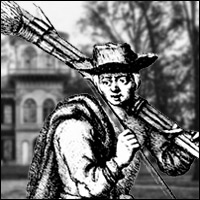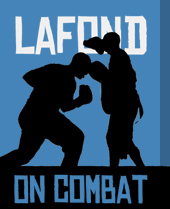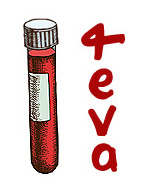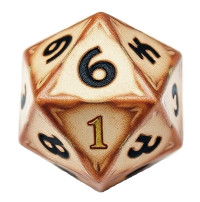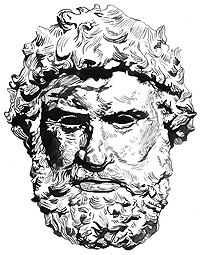“Keeping on our course, we reached what appeared to be the mouth of a very great river. However, it was not, as we had believed, a river, but a broad harbor. Because there was land on both sides, and as the water was so wide as to appear like a strait, our pilot Aliminos said that this was where the island ended and the mainland began. So we called it Boundary Bay, and it remains so-named on the charts. It was, after all, a lagoon, bounded by islands, with three channels.
“Our Captain Grijalva went ashore with the other captains and soldiers, and we [1] spent three days taking soundings at the mouth of the strait. After thoroughly exploring the bay in an attempt to establish its proportions, we determined that there was no island, but that we were riding at anchor in an excellent harbor.
“On shore there were some buildings of stone that served as chapels, which housed many idols of baked clay, wood and stone. Some were female figures, others stylized serpents, and there were many deer’s antlers.
“There must be a town close by, we thought, since a place served by such a fine harbor would be a good site for a settlement. We were mistaken. [2] It was desolate of habitation, and the chapels merely served those traders and hunters who happened by while passing in their canoes to offer sacrifice. [3] The rabbit and deer hunting was good, and with the aid of a greyhound bitch we killed ten deer and took many rabbits. When we had finished exploring we set sail and the bitch stayed behind. [4]
“Sailing by day westward, close to shore, but not at night for fear of reefs and shallows, after three days we sighted the mouth of a very wide river. We lowered our boats and discovered by sounding that the two larger ships could not enter. It was agreed that these two capital ships should anchor beyond the river mouth at sea, and that all our soldiers should go up the river in the two smaller ships and the ships’ boats.
“We decided on this approach after seeing many Indians armed with bows and arrows and their various other weapons, lying in canoes alongside the riverbanks, and concluded that there was a large town close by. Also, as we sailed, we had seen fishing nets along the coast and had taken fish from two of them.
“This river was named the RioTabasco after the Cacique of this large town. But since we discovered it on this voyage, and Juan de Grijalva was the discoverer, we called it the Rio de Grijalva and so it is marked on the charts to this day.”
Notes
1. We have the good fortune of being the heirs to an account written by a man to have had the mixed blessing of being highly valued by his superiors for his abilities, but not a favored companion of these same leaders, as indicated by this passage, which obliquely refers to his pulling harbor sounding duty while the brass drank wine on the beach.
2. By this point in the narrative it is quite apparent that the Spanish, hailing from a peninsula that was virtually an island ringed by great ports and subdivided by a harsh interior, were having some difficulty grasping the fact that—despite having ocean going canoes—the inhabitants of this New World did not engage in maritime activity, and preferred to orient themselves along the interior lines of their rugged and isolated lands. Conquering the mountain empires of the New World would be much more difficult than sailing into Asian ports, guns blazing, with mutilated enemies mounted on the bowsprit, as their Portuguese counterparts had done in the Indian Ocean.
3. The sacral life of the natives would continue to baffle the Spaniards.
4. Until the Soto expedition, some 20 years later, there were not a lot of mention of dogs—man-eating dogs to be exact—in Spanish accounts. The first generation of Spanish-speaking Aztec priests, who converted to Catholicism, did however, record their impressions. The natives were terrified of the giant European dogs, which, from Diaz’s time, up until the 1790s, and the failed French effort to reclaim the colony that had risen up and become Haiti, were bred and trained on Cuba. They were ultimately descended from three breeds:
A. The Italian mastiff that had once served as the war dog of the Roman legions, and had done guard duty in Italy for a millennium, was modified to a more rugged hunting animal over the course of the 100 or so years that the Spanish spent taking the Canary Islands from the Stone Age natives. The men of the mountainous island of Gomera [where every Spanish expedition to the New world took on water before the Atlantic crossing], and the dogs bred there, were used to hunt the natives of the three major Islands. Later, men such as Ponce de Leon perfected their use in hunting down the naked inhabitants of Puerto Rico, Jamaica, Hispaniola and Cuba.
B. The greyhound, favored as a hunting dog by European nobility for centuries, and known for its ability to take down men, such as in the famous duel between the Chevalier Maquer and the dog belonging to the slain Aubry de Montdidier—who by its behavior had accused the chevalier of the crime—adapted well as chase dogs. These assisted in the hunting of game, and of running down fleeing Indians.
C. The Irish wolfhound was an ideal man-hunting beast, and appears to have accounted for many of the mentions of greyhounds and hounds.
These three breeds of dogs would often be armored, and were feared by the Indians more than the horses. The most common penalty decreed by Spanish governors upon uncooperative natives, was to be “thrown to the dogs.” Imagine how the Spanish entradas must have seemed to the natives. These were not simply armies of men, but invading ecosystems: men, horses, dogs, and pigs, which continue to plague the Southern United States to the present day. Note that the greyhound bitch that Diaz and the others were so fond of, decided to stay.




